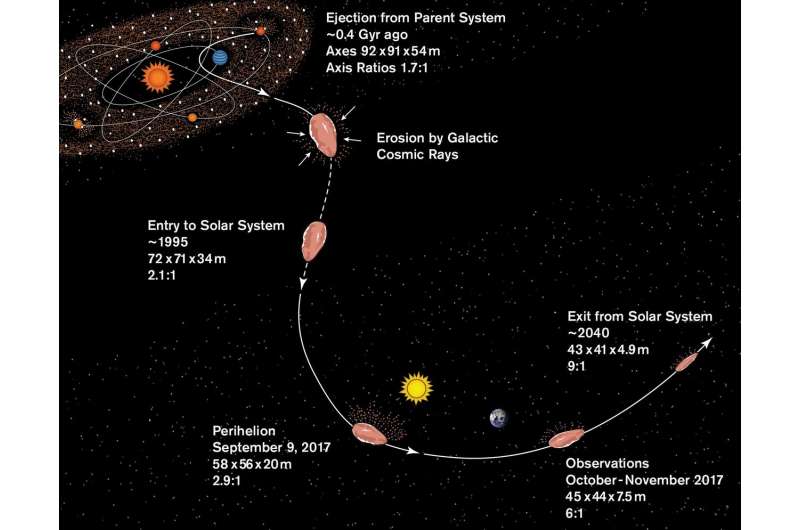The extrasolar object ‘Oumuamua is one of the most extraordinary and controversial objects ever observed. Not only extrasolar, but weird in many ways, it is one of the few astronomical sightings for which “alien technology” is a real possibility. In fact, there are few hypotheses that are even as plausible as alien technology.
This spring, researchers from Arizona State describe a new theory of the possible natural origin of ‘Oumuamua [2, 3].
The study suggests that the body could be a chunk of ice, but not CO2 or water or other common constituents of comets. They find that a chunk of pure frozen Nitrogen (N2) would have the observed mass of ‘Oumuamua. It would also have a high albedo, consistent with the observations. Also, the high albedo would mean that the object was smaller than other estimates, less than 50m in length.
Furthermore, sublimating Nitrogen could have produced jets that would account for the observed change in trajectory near the sun, especially for a small object with less mass. Sublimating Nitrogen would not have been spotted by the telescopes as CO or CO2 would be, and the smaller object would have been invisible to the Spitzer telescope, as happened.
Now, I can hear Professor Loeb thinking, “OK, so a giant chunk of pure Nitrogen. How is this more plausible than alien technology?” : – )
So the study fleshes out the overall scenario.
The researchers point out that in our solar system Pluto and Triton has large areas of frozen Nitrogen on its surface. Assuming the observations are correct, any large collision involving Pluto would eject chunks of N2 ice. So, it is plausible that there could be quite a few sources of Nitrogen comets, especially in a young star system.
The researchers examine the possible history of ‘Oumuamua. In this scenario, the object about 90m in diameter was broken off an “exo-Pluto” in a young star system, and ejected into interstellar space. If this was about 500 million years ago, it would have eroded to about half that size by interstellar radiation on its way to us. This erosion could have sculpted the inferred oblate shape. With certain assumptions, this would also account for the object travelling at close to the local standard of rest (LSR), as was observed, even though the object would have had much different velocity initially.

OK, I will say right now that I am not competent to evaluate the details of these studies. I’m sure they will be checked and critiqued very carefully.
While I personally would love ‘Oumuamua to be an alien artifact, I agree with these authors that the Nitrogen ice object is pretty interesting and weird in its own right.
On a sociotechnical note, I’ll point out that Desch, Jackson, Loeb, and every other astronomer agree that the next logical step is more and better telescopes [1]. (And, of course, more and better astronomers! And better pay for astronmers. : – ) )
- Arizona State University, Scientists determine the origin of extra-solar object ‘Oumuamua, in phys.org – News, March 17, 2021. https://phys.org/news/2021-03-scientists-extra-solar-oumuamua.html
- S. J. Desch and A. P. Jackson, 1I/‘Oumuamua as an N2 ice fragment of an exo-pluto surface II: Generation of N2 ice fragments and the origin of ‘Oumuamua. Journal of Geophysical Research: Planets, n/a (n/a):e2020JE006807, 2021/03/16 2021. https://doi.org/10.1029/2020JE006807
- Alan P. Jackson and Steven J. Desch, 1I/‘Oumuamua as an N2 ice fragment of an exo-Pluto surface: I. Size and Compositional Constraints. Journal of Geophysical Research: Planets, n/a (n/a):e2020JE006706, 2021/03/16 2021. https://doi.org/10.1029/2020JE006706

One thought on “A New Hypothesis about ‘Oumuamua”